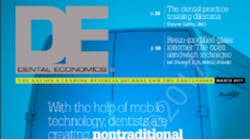Perio pathogens cause atherosclerosis
Dr. Richard Nagelberg stresses the critical need for salivary testing to identify the bacteria involved in periodontal disease, as diminishing the likelihood of a cardiovascular event from atherosclerosis is now the enormous opportunity and responsibility of dental professionals.
"From a clinical perspective there is a significant difference between being associated with versus being causal of a disease. Optimal management of an associated condition may not impact the end disease, whereas such management of a causal condition would have a favorable effect on the end disease." (1)
For decades, there has been a spectrum of acceptance of the associations between the mouth and body, ranging from skepticism to early implementation on preliminary evidence. Most clinicians fall somewhere between the two extremes. There is now a mountain of evidence indicating some level of interconnection between the mouth and the body to the point that there is general acceptance of the impact of periodontal disease (PD) and periodontal pathogens on the vasculature. Many of the studies in this arena conclude by stating that more studies are needed to demonstrate causality or that interventional studies are needed for causality to be determined. Interventional studies would investigate the impact of periodontal treatment on the incidence of cardiovascular disease. There are many challenges inherent in this type of study, so we have been stuck in a place where we have known one affects the other but could not say one causes the other, until now.
The authors of a recent journal article undertook a novel approach. (1) Bradley Bale, MD; Amy Doneen, DNP, ARNP; and David J. Vigerust, MS, PhD, examined the factors necessary for defining causality. They indicated that there are three requirements for the formation of atherosclerosis (ASVD): serum lipoprotein concentration, endothelial permeability, and lipoprotein binding in the intima layer of the arterial wall. Any medical condition, agent, or other element that can influence all three requirements in a manner favoring the development of ASVD can be concluded to be a contributory cause of the disease.
The article states that certain pathogens associated with PD are contributory causes of ASVD, including Aggregatibacter actinomycetemcomitans(Aa), Porphyromonas gingivalis (Pg), Tannerella forsythia (Tf), Treponema denticola (Td), and Fusobacterium nucleatum (Fn).
Serum lipoproteins are the major transporters of cholesterol and triglycerides in the bloodstream. Examples include LDL and HDL. An essential element in the development of ASVD is the concentration of certain lipoproteins, specifically high LDL levels, which is common knowledge. Research has concluded that the high-risk perio pathogens A. actinomycetemcomitans, P. gingivalis, T. forsythia, and T. denticola can increase serum lipoprotein concentration, promoting ASVD pathogenesis.
The second element needed for ASVD is endothelial permeability. The endothelium is the layer of cells lining the interior of arteries. It is only one cell layer thick. Formation of an atherosclerotic plaque in the arterial wall requires white blood cells and lipoproteins, including LDL, to penetrate the endothelium. It is the accumulation of lipoproteins in the artery wall that will form the core of the atheromatous plaque. The authors concluded that high-risk perio pathogens such as F. nucleatum can increase endothelial permeability via a number of different mechanisms, including breaking down endothelial cell-to-cell junctions and creating gaps in the arterial wall, among others.
The third triad requirement is lipoprotein binding in the intima, which is the innermost layer of the artery wall. The periodontal bacteria P. gingivalis can increase the binding of lipoprotein in the intima layer.
The authors concluded: "There is scientific evidence that PD caused by the high-risk pathogens can influence the pathogenesis triad in an adverse manner. With this appreciation, it is reasonable to state PD, due to high-risk pathogens, is a contributory cause of atherosclerosis. Distinguishing this type of PD as causal provides a significant opportunity to reduce arterial disease." They further concluded: "PD due to high-risk microbes must be treated effectively to reduce the risk of ASVD."
The primary takeaway is the critical need for pre- and post-op salivary testing to identify the bacteria, since the research indicated their causal property rather than the inflammatory properties of PD. Diminishing the likelihood of a cardiovascular event, such as a heart attack or stroke, from atherosclerosis is an enormous opportunity and now our responsibility.
Reference
1. Bale BF, Doneen AL, Vigerust DJ. High-risk periodontal pathogens contribute to the pathogenesis of atherosclerosis [published online November 29, 2016]. Postgrad Med J. doi: 10.1136/postgradmedj-2016-134279.
Richard H. Nagelberg, DDS, has practiced general dentistry in suburban Philadelphia for more than 30 years. He is a speaker, advisory board member, consultant, and key opinion leader for several dental companies and organizations. He lectures on a variety of topics centered on understanding the impact dental professionals have beyond the oral cavity. Contact Dr. Nagelberg at [email protected].
